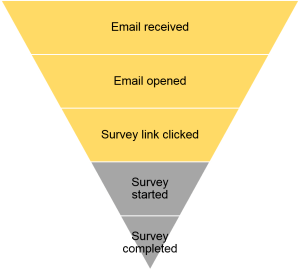Survey Administration Best Practices
Crafting Effective Communications
Since 2000, Ithaka S+R has run the US Faculty Survey, which tracks the evolution of faculty members’ research and teaching practices against the backdrop of increasing digital resources and other systemic changes in higher education. Starting in 2012, Ithaka S+R has offered colleges and universities the opportunity to field the faculty survey, and a newly added student survey, at their individual institutions to gain better insight into the perceptions of their faculty members and students. More than 70 local faculty and student surveys have been fielded thus far and have enhanced Ithaka S+R’s expertise in higher education survey administration.
This post is the second in a series on survey administration best practices. Ithaka S+R is often queried about our survey administration processes, and this series of blog posts explore both our experience in fielding surveys and current research from email marketers. Before reading this blog post, you may want to read the first one in the series on ensuring your survey invitation is received and opened.
Once a respondent has received your message and opened your email, you need to make sure that you have crafted a message that entices the recipient to click on the link to your survey.
The number of participants who start and complete the survey are dependent on these preliminary steps. Maximizing the number of recipients who click on the survey link will, in turn, help to increase the response rates.
The following recommendations will help you in crafting effective communications in encouraging recipients to take your survey. These recommendations should be interpreted in the context of both the sender and the recipient of the communication, as your experiences may vary depending on these factors.
Personalize the message
Many survey platforms allow you to pipe in personal information, such as a respondent’s name. Simply including a respondent’s name in addressing the email (i.e. “Dear [FirstName]”) can lead to increased response rates.
Make sure to address the respondent in way that would be most appropriate to the respondent. For example, “Dear [FirstName]” would be fitting for a more informal invitation or reminder message, whereas “Dear [Title] [LastName]” might be more appropriate for a more formal message to a respondent for whom his/her title is of importance.
Explain your purpose
Explain why you are sending this message to this individual. Let them know that they are a part of a specific group that has been selected to participate in this survey.
Tell the recipient why you are running the survey and what you intend to do with the findings. Mention how participating will benefit them and, if possible, how the respondent can gain access to the findings from the survey once they are available. Those who participate in the Ithaka S+R local surveys program often use this space to mention specific initiatives, campus collaborations, and/or consortia efforts that are relevant to the survey.
If relevant, make sure to explain if the data will be kept confidential or anonymous. This is especially important for surveys that collect potentially personal or sensitive information. If you are conducting a survey within an academic setting, check with your Institutional Review Board to see if there is specific information that must be included.
Set expectations
Mention how long the survey will take and when the survey will close. Make sure that you have thoroughly tested the survey to give an accurate estimate of the length of time it will take the respondent to complete the survey. Overestimating can lead to fewer click-throughs, whereas underestimating can lead to low completion rates and unhappy respondents.
Mention any incentives
If you are offering an incentive for participation, make sure to mention this in your messaging. Incentives have the potential to significantly increase response rates, especially when the incentive is determined based on what motivates your audience.
If you are promising anonymity in your survey, make sure that there will not be any possibility of re-identifying respondents through a form they might fill out to receive the incentive. For example, Ithaka S+R has the ability to set up a separate form for prize drawings that are held completely separately from survey responses; including an incentive does not compromise the anonymity of respondents.
Thank the respondent
Prior to ending the survey invitation or reminder message, make sure to thank the recipient in advance for their participation, further encouraging the individual to complete the survey.
Overall
The content, length, and structure of your communication should be determined with your audience in mind. Through the Ithaka S+R local surveys program, we work with participating institutions to craft these messages, using differing strategies for faculty and student surveys.
In my next blog post, I’ll focus on general strategies around sending invitation and reminder messages, including how many reminders should be sent and what times are best for distributing these messages.
